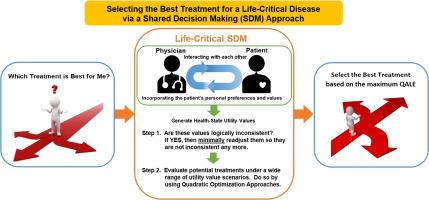Journal of Biomedical informatics ( IF 4.0 ) Pub Date : 2020-11-18 , DOI: 10.1016/j.jbi.2020.103604 Evangelos Triantaphyllou 1 , Juri Yanase 2

|
Background
Selecting the best treatment for life-critical conditions via a shared decision making approach is a uniquely important challenge. Besides data from the healthcare physicians, other data that need to be considered are the personal values and perceptions of the patient. Usually, these data come in the form of health-state utility values. They are subjective and often times are elicited from the patient under emotional and stressful conditions. This paper examines an approach for selecting the best treatment under a life-critical shared decision making (SDM) framework.
Methods
Health-state utility values are used in practice to quantify what is known as quality-adjusted life years (QALYs) and quality-adjusted life expectancy (QALE). The QALEs from different treatments are used to select the best treatment. This paper describes methods for determining QALEs under a range of scenarios defined by the way some key assumptions on the health-state utility values are satisfied. Approaches for comparing different treatments are described along with some counter-intuitive results. These approaches are based on some optimization formulations. The proposed approaches are demonstrated in terms of a real example taken from the literature.
Results
Having results that are robust under a spectrum of different scenarios can provide more confidence that the most suitable treatment has been selected in a given case. On the other hand, having non-robust results can be useful information too as they may provide evidence that a more thorough assessment of the benefits and harms of the treatments may be needed to select a treatment with higher confidence. Finally, this study demonstrates that under certain mathematical conditions among the data it is possible to decide which treatment is better among two treatments without having to use health–state utility values.
Conclusion
The significance of this study is that it provides valuable and actionable insights for the important question of how health-state utilities can be used in treatment selection.
中文翻译:

健康状态效用情景下生命关键型共享决策的治疗选择
背景
通过共同的决策方法为生命关键的状况选择最佳治疗方法是一个非常重要的挑战。除了来自医疗保健医生的数据外,还需要考虑的其他数据是患者的个人价值和看法。通常,这些数据以健康状态效用值的形式出现。它们是主观的,通常是在情绪和压力条件下从患者身上引起的。本文探讨了一种在生命攸关的共享决策(SDM)框架下选择最佳治疗方法。
方法
在实践中,使用健康状态效用值来量化所谓的质量调整寿命(QALYs)和质量调整寿命(QALE)。来自不同治疗方法的QALE用于选择最佳治疗方法。本文介绍了通过满足健康状态效用值的一些关键假设而定义的一系列情景下确定QALE的方法。描述了比较不同治疗方法的方法以及一些与直觉相反的结果。这些方法基于一些优化公式。所提出的方法是根据文献中的一个实际例子进行证明的。
结果
在一系列不同情况下获得可靠的结果,可以更有把握地确定在给定情况下已选择了最合适的治疗方法。另一方面,具有非稳健的结果也可能是有用的信息,因为它们可能提供证据,表明可能需要更彻底地评估治疗的利弊,以选择具有更高信心的治疗方法。最后,这项研究表明,在数据中的某些数学条件下,无需使用健康状态效用值就可以确定两种治疗中哪种治疗更好。
结论
这项研究的意义在于,它为如何使用健康状态实用程序进行治疗选择这一重要问题提供了有价值且可操作的见解。









































 京公网安备 11010802027423号
京公网安备 11010802027423号